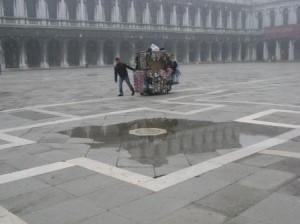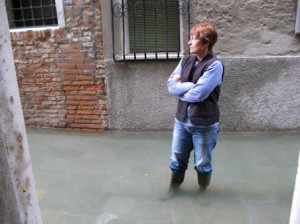We’re sitting here holding a sort of tense little domestic vigil awaiting the end of the world, which is predicted to reach Venice some time tonight.

Briefly, a huge weather system is moving across Italy and will be bringing high winds, torrential rain, and acqua alta, or high water, sometime tonight. I say “sometime” because Things Might Change (at least slightly — maybe the wind won’t settle into the southeast after all, for example) but we’re going to be getting wet. Just how wet is the question that is keeping the lights burning in our little hovel.
The tide is going to turn and begin to rise about 3:00 AM. Which means we can expect to hear the municipal high-water warning sirens begin to wail not very long after that.
The tide forecast is: Maximum at 9:30 PM tonight at 75 cm [29 inches above mean sea level] ; minimum at 2:25 AM at 45 cm [17 inches]; maximum at 8:35 AM at 130 cm [51 inches]; minimum at 3:40 PM at 20 cm [7 inches].

My only hope and prayer at this point is that the tide will only reach the three-tone level, because that means we’re still dry. We discovered last December 1 that when we hear four tones, we’re basically doomed.
We had water in our very own domicile; what was unnerving wasn’t so much its height (I guess it never exceeded an inch on the floor) as its inexorability. I can’t recall a sensation to compare it to: The realization that you can’t do one single thing to stop it. I suppose going into labor might be something similar.
I can tell you that the garbagemen are working an extra shift right now, setting up the temporary walkways in the parts of the city which will certainly be submerged to some extent, especially around the Piazza San Marco, the lowest point in the city.
There is also absolutely no doubt that Paolo Canestrelli and his band of hardy forecasters are working the lobster shift at the Tide Center, refining their predictions probably minute by minute. What they really, really hate is to turn out to have gotten the numbers wrong. People may snicker at them when the tide doesn’t rise as high as they thought it would, but people rage and snarl and shriek when they estimated too low. Not a job I’d be at all interested in having.
For the record, a normal tide (measured in height above mean sea level) is between -50 cm and +79 cm [minus 19 – plus 31 inches.] One siren tone.
Code Yellow (“sustained tide”) is between +80 and +109 cm [31 – 42 inches.] Two tones.
Code Orange (“very sustained tide”) is between 110 cm and 139 cm [43 – 54 inches.] Three tones.
Code Red (“exceptional high tide”) is over 140 cm [55 inches.]

In case anyone has heard about the MOSE floodgate project (perhaps to be operational in 2012), intended to block high tide from reaching the city, I want to point out that it is intended to be used only in the case of Code Red. Which means that for 3/4 of the high-tide events, we’re still going to be pulling on our wellies.
Another point: The numbers don’t really tell you much because Venice is not uniformly level. So a number in one place isn’t going to signify the same experience in another — sometimes even just 50 yards down the street.
More tomorrow, at some point. Going back to doing laps around the rosary.

4 Comments
Hi Erla, I remember very well last december 1, when I was checking the tide center website nervously every minute, thinking of you, trying to guess if the water can enter your appartment, and then, when the water was sinking again, pondering how long I should wait before I can call you without disturbing you too much.
Today, however, I got up a bit late and don’t know the details. But it seems to me that the water didn’t rise like last year, and you didn’t have any particular problems, right? I hope so!
I had thought that they were going to use MOSE also for code orange. Maybe they changed their minds in order not to disturb the ship traffic or the natural water flow too much. But anyway, I don’t know what to thnk about that weird MOSE.
As far as I have heard — that is, read in the press, of which I am more skeptical every day — MOSE has always been intended to be used in cases of “exceptional high water,” which the city defines as being above 140 cm. I can only speculate as to the reasons for this. I will be writing a piece on MOSE before long, which ought to give more context than is usually reported in the (see above) press.
Thank you, I’m looking forward to read your article!! It’s great how you always do detailed research on context and everything.
There’s a site which seems to be the official website of MOSE – http://www.salve.it
Of course it’s biased and says that MOSE is awesome in every way. But they should be good for “technical” information.
Anyway, at the moment they do say that it’s going to be activated at 110 cm.
Maybe the press just writes “exceptional high water”, because any high water that is not exceptional doesn’t interest the Venetians very much.
Quote: “Attualmente, il livello di marea previsto per l’entrata in funzione delle paratoie è 110 cm (rispetto al mareografo di riferimento posto a Venezia, Punta della Salute). Si tratta di una accordo preso dalle Istituzioni competenti, in base alla quota cui si è deciso di rialzare le rive delle parti più basse dei centri lagunari. Tale livello non rappresenta, dunque, un limite funzionale del sistema di difesa e può essere rivisto e abbassato qualora ritenuto necessario.”
Thanks for the clarification. Eventually I’ll be interested to learn how much time is required to position the moveable barriers. Because in theory they should have been raised this morning before 6:00 AM (when the sirens sounded, with two tones: Code Orange) and yet the water in our canal barely came above the edge of our fondamenta. I walked around all morning in my street shoes. There was undoubtedly more water in the Piazza San Marco, but not as much as yesterday. This is not to say that the Centro Maree’s estimates can’t be wrong — and they understandably prefer the “safe rather than sorry” approach to forecasts. But if they tell the MOSE-wranglers it’s Code Orange, the gates could be activated to block a tide that didn’t show up. Even that doesn’t matter unless you’re concerned (as are a number of independent engineers) about the cumulative effect of frequent usage — wear and tear, in simpler language. If the gates are raised too often, they may well (as with most mechanical creations) begin to show some fatigue. This will almost certainly lead to other problems which I am not certain that the MOSE cheerleaders have acknowledged.